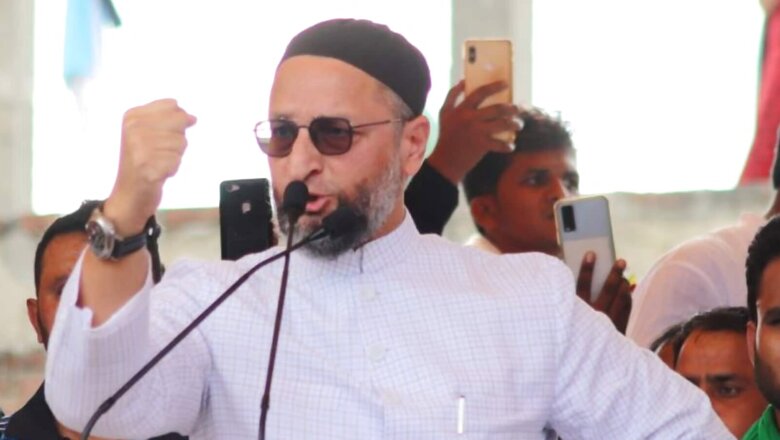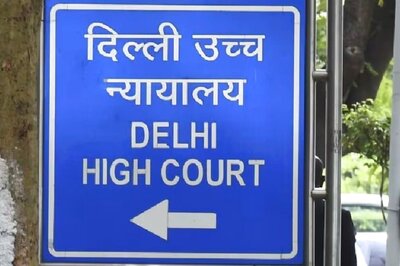
views
For the past five years, All India Majlis-e-Ittehad-ul-Muslimeen (AIMIM) chief Asaduddin Owaisi has been trying hard to increase his footprints in Uttar Pradesh. His appetite has been further fuelled by his party’s slow but steady expansion beyond the boundaries of Telangana. Winning a Lok Sabha seat from Maharashtra in 2019 and then a couple of victories in assembly polls in the state, followed by a stunning haul of five seats in the 2020 Bihar assembly polls have clearly added wings to the AIMIM’S ambitions. But unlike Bihar, Uttar Pradesh remains a major challenge. This is despite the fact that UP has the biggest Muslim population among Indian states. For Owaisi, there are several contradictions at play and fighting them out will not be easy.
On September 7, in his interaction with journalists in Lucknow before heading to the district of Ayodhya for a party event, Owaisi had no qualms accepting how the AIMIM lacked an organisational base until very recently. However, he said, his party has moved ahead since 2017, when it contested 38 seats in assembly polls and lost deposits on 34 of them. Most of these seats had a sizeable presence of Muslims.
The AIMIM now intends to contest not less than 100 seats in the UP elections early next year. Owaisi is also hopeful about the sustainability of his alliance with a few other smaller caste-based parties that have together come to float the Bhagidari Sankalp Morcha. “The past is behind us. Our party will make its presence felt in the state in the 2022 polls,” he said. “The minorities have been cheated by parties like the SP and the BSP. For how long will Akhilesh and Mayawati ji take the Muslims for a ride in the name of the BJP’s threat, get their votes and then not stand for their issues?”
Owaisi’s hopes and the Muslim paradox
In a textbook scenario, UP should be a fertile ground for AIMIM’s politics. Though compared to West Bengal, Muslims here constitute a smaller percentage of the voting bloc, but in terms of population across the country, it is the biggest. Muslims have a moderate to high presence in several constituencies, especially in regions of western UP and Rohilkhand, spanning districts like Meerut, Shamli, Muzaffarnagar, Aligarh, Moradabad, Bijnor and Bareilly. Theoretically speaking, there is a huge deposit of reserves for the AIMIM to cash in on.
However, in practicality, it didn’t happen as expected, at least in the 2017 assembly contest. The total votes polled by the AIMIM on all 38 seats it contested was around 2 lakh. The party even lost its deposits on 34. Out of the 38 seats, 22 went to the BJP, 15 to the Samajwadi Party, and one to BJP ally Apna Dal.
But even in its poor performance, the AIMIM could also be seen as being responsible for the BJP’s victory in four seats, including that of Kanth in Moradabad that had become a hotbed of communal polarisation following a controversy over the removal of a loudspeaker from a temple.
Here, the BJP’s victory margin against the SP was 2,348 votes and the AIMIM candidate got around 23,000 votes. The BJP netted around 76,000 votes, while the SP about 73,500. The BSP got around 49,000. Both the SP and BSP, like the AIMIM, had fielded Muslim candidates. Given the prolonged existence of the SP and BSP in Uttar Pradesh’s politics, one can argue that more than the BSP, it was the AIMIM that jeopardised the SP’s calculations.
In Tanda constituency of Ambedkar Nagar, the BJP won by a margin of just 1,725 votes and the AIMIM got 2,000 votes. In Gainsari in Balrampur district, the BJP again was victorious by only 2,300 votes and the AIMIM picked up 3,160. Neighbouring Shrawasti too went into the BJP’s kitty by a margin of just 445 votes, thanks to the AIMIM candidate grabbing 2,900 votes.
In the tsunami of victory where the BJP bagged 300 plus seats, not much attention was paid to this small impact of the AIMIM. But the writing on the wall was clear. The question is, what impact will the AIMIM have in a scenario of a close contest when the road ahead for the BJP is no longer as smooth as it was in 2017.
It is here that the ‘Muslim paradox’ is the most profound. Owaisi is highly admired by a strong section of the community. His oratory skills and aggressive stands on issues close to the heart of the bulk among the Muslims has significantly enhanced his charisma over the past few years. But then comes the political reality where Muslims alone cannot be the key to electoral victory and pushing the BJP out of power.
Hence, they need to go in an alliance with a party that already has a sizeable caste-rooted support base and together hope to unsettle the BJP. From the late 1980s to date, Muslims in Uttar Pradesh have therefore been firmly associated with the forces of ‘Mandal politics’, seen as the antithesis to the BJP’s Hindutva consolidation.
Over the years, it is the Samajwadi Party that has been the biggest beneficiary of Muslim support. Its Muslim-Yadav combination, or the ‘M-Y factor’, played a big role in the formation of the majority government under Akhilesh Yadav in 2012. In 2007, Muslims chose the BSP over the SP, when Mayawati’s Dalit-Brahmin equation had given it a strong pitch against the BJP.
Senior journalist Asad Rizvi says, “For a majority of Muslims, Owaisi is a sort of icon, but they also realise that willingly or unwillingly Owaisi’s politics can ultimately help the BJP. When the priority is to keep the BJP out of power, voting for the AIMIM can be counterproductive. The rise of the BJP in 2017 and further strong narrative of hardcore Hindutva under Yogi Adityanath has made Muslims more aware of the necessity to ensure the minimum possible split in the community’s vote.”
Yogi’s staunch Hindutva: A boon for Owaisi or a roadblock?
Over the past four and a half years, the BJP’s government in Uttar Pradesh had also been under a lot of focus because of CM Yogi Adityanath’s aggressive Hindutva push. From the issue of Ayodhya to allegations of targeting Muslims in the name of law and order, the Yogi government had simultaneously enhanced both Hindu polarisation as well as counter-polarisation.
According to senior journalist Virendra Nath Bhatt, “Unlike any other BJP-ruled state, in Uttar Pradesh Yogi Adityanath is himself a big factor of polarisation. If his politics has helped the BJP in cementing the Hindu vote base across upper castes and non-Yadav OBCs, it has also led to the counter-polarisation of Yadavs and Muslims. In an election that can also be a lot about the pro-Yogi and anti-Yogi phenomenon, Owaisi can either be a gainer or a big loser, depending upon how politics pans out over the next few months.”
While Owaisi hopes to tap into the rising discontent among the minorities, the very fact can also lead to Muslims doing very strategic voting in order to push the BJP out of power. No doubt there is an increasing realisation not to repeat the mistake of the past when Muslim votes got fragmented primarily between the SP and the BSP.
Owaisi clearly realises the underlying danger and therefore is keen to forge some alliance with the smaller caste-based parties in the state. How smooth these alliances including that of the Bhagidari Sankalp Morcha will be is still not clear. The BJP, however, will hope that Owaisi emerges as the much-needed ‘vote divider’, thereby making some dent into the Samajwadi Party’s calculations.
Amidst a plethora of possibilities, there is no doubt that Owaisi has made the UP contest an interesting one. “Even in his defeat, he might make a big difference”— that is what the BJP will hope for and the Samajwadi Party will wish does not happen. A lot will depend solely on how Muslims treat their ‘star’ in the electoral battle.
Read all the Latest News, Breaking News and Assembly Elections Live Updates here.

















Comments
0 comment